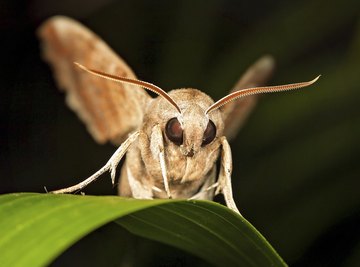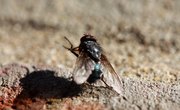
Leave a light on in warmer months and you'll find that many insects fly at night. They range from tiny midges to lumbering beetles and large moths. Kinds of nocturnal insects vary according to where you live. For instance, deserts have far different insects from forests. Near water, aquatic insects produce abundant night fliers. Nocturnal insects are food for many other animals, such as bats, nighthawks, scorpions, rodents and owls.
Beetles
Flying beetles are common when brown May and June beetles hatch from underground pupae and fly to mate and lay eggs. They belong to the scarab family, which also contains impressive or colorful nocturnal flying beetles such as the rhinoceros beetle and the gold beetle. Long-horned beetles have slender, long, arching antennae and chunky cylindrical bodies. Fireflies that fly are male beetles. Females usually rest on bushes observing male light signals, ready to flash back.
Moths
Nearly all moths are nocturnal fliers. They range in size from small moths that need magnification to be seen properly, called microlepidoptera, to larger moths such as sphinx moths, underwing moths and cecropia moths, which can possess beautiful wing colors and designs. Many moths don't feed as adults, concentrating only on finding a mate and laying eggs before they die. In most areas you'll see an abundance of small to intermediate-size moths in rather nondescript browns and grays; these are adults of inchworms and cutworms.
Flies
Perhaps the least-appreciated nocturnal flies are mosquitoes. Female mosquitoes need a blood meal to lay eggs. They fly to find a host, including birds such as herons, robins and house sparrows, and mammals such as livestock and humans. Then they fly to find water to lay eggs in. The leathery larvae of craneflies live in water or damp areas. The long-legged adults are harmless, although many people think they are giant mosquitoes. They are most active around dusk. Small, bottom-dwelling worm-like aquatic fly larvae produce night-flying midges with feathery antennae.
Net-Winged Insects
Neuroptera, or net-winged insects, have four wings of about equal size, each with a network of many fine veins. Green lacewings are common at night, with slender light-green bodies and delicate long wings. Fluttering flight takes them to food and egg-laying sites. The larvae eat aphids. Adult antlions have long slender abdomens and elongated, clubbed antennae. Unlike the fierce larvae, which build pits to trap ants, adults don't feed.
Grasshoppers and Relatives
The preying mantis lurks in shrubbery or at the edge of lights. They fly to hunting locations and then wait for prey. Katydids, often with forewings resembling green leaves, are nocturnal. Usually not strong flyers, they fly to find appropriate plants to eat, and to mate and lay eggs. Sometimes tree crickets and grasshoppers fly to lights at night.
Aquatic Insects
In addition to the true flies, or Diptera, some night-flying insects are called flies but are not true flies. Mayflies hold transparent wings folded erect over their backs and have three slender appendages on their tails. Caddis flies resemble moths, with wing colors due to hairs rather than scales. They hatch from water-dwelling larvae that build little cases they inhabit.
True Bugs
A blood-sucking true bug inhabiting the Southwest, the kissing bug lives in rodent nests as a nymph, feeding on its host's blood. Mature, winged adults take flight at night to find a mate, and females need a blood meal to form eggs. They will feed on humans and their pets. When eggs are ready, females fly to a host nest to lay eggs. The adults often fly to lights at night.
About the Author
Carolyn Csanyi began writing in 1973, specializing in topics related to plants, insects and southwestern ecology. Her work has appeared in the "American Midland Naturalist" and Greenwood Press. Csanyi holds a Doctor of Philosophy in biology from the University of Wisconsin at Madison.
Photo Credits
pelooyen/iStock/Getty Images
